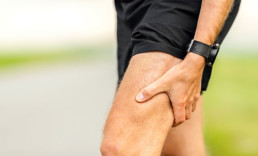If you work for a large organization or are required to deal with one, you may have been hamstrung – prevented from taking action – by the endless bureaucracy. But hamstrings? What are they and what’s the relation between the two words?
Hamstring vs. Hamstrung
The hamstrings are the long, tendonlike muscles that run along the back of your thigh from buttocks to knee. The first syllable comes from the Old English ham or hom, meaning the hollow or bend of the knee; the strings refer to tendons. Put the syllables together and you have hamstrings: the tendons at the bend of the knee.
If you are hamstrung, technically you have been crippled by these tendons being cut; less literally however, you have been prevented from acting or being efficient.
Hamstrings Explained
Your hamstrings are crucial to your body’s motion. There are three hamstring muscles that extend from your buttocks to your knee. Your hamstring muscle group consists of the biceps femoris, the semitendonosus, and the semimembranosus. This trio of muscles is the grouping that is primarily responsible for straightening your hip and bending your knee.

What Does a Strained Hamstring Feel Like?
If your hamstring strain is a mild one, you may not even notice it until you stop exercising or until the next day when there might be tightness, soreness and bruising; however, the strength of your hamstring shouldn’t be affected.
More severe hamstring injuries include symptoms that may include a sharp, sudden pain in the back of your thigh or in your buttocks; a sensation of popping or tearing in the muscle; swelling; bruising; tenderness when touched; the inability to straighten your leg or lift it when lying down; and challenges in walking or in sitting comfortably.
With a Grade II strain, you’ll lose some leg strength and if the strain is a Grade III strain, you’ll likely be unable to use your leg.
Hamstring Injuries
Hamstring injuries generally result when the muscles come into contact with excessive force. The sudden starts and stops that athletes make while running or the cutting or jumping movements they make when playing soccer or basketball may cause a strained hamstring.
Overstretching the muscles while lifting something heavy or while hurdling or kicking can also result in injury to your hamstring group. The muscles may even become overloaded which can result in a hamstring tear. A sudden increase in the intensity of exercise or training can lead to hamstring injuries, as can running on hard surfaces, poor pelvic alignment and stress on the body due to obesity.
Hamstring strains come in three flavours, or degrees or seriousness:
- A Grade I hamstring strain (or tendinitis) is a mild overload with minimal muscle tearing involved; it will feel like a muscle pull or cramp.
- A Grade II hamstring strain is a moderate strain with partial tearing of the muscle that may be accompanied by a stinging or burning feeling at the back of your thigh.
- A Grade III hamstring strain, the most severe, is a completely torn muscle that may leave a knot or lump at the spot where the tear has happened.

Treatment for a Strained Hamstring
How to treat a strained hamstring depends on the severity of the strain. Mild strains can be treated at home, similar to any other minor sports injury. The RICE approach works well: rest, ice, compression and elevation. Avoid physical activity; apply cold packs to your hamstring for 15 to 20 minutes every few hours; use an elastic bandage to wrap and compress the thigh to reduce swelling; and keep your leg raised on pillows to further minimize swelling. You can also take over-the-counter painkillers, such as non-steroidal anti-inflammatory medicines.
If the strain is severe, surgery may be required to repair the tear. Consult with your physician if you suspect a Grade III strain.
Once the initial pain and swelling are through, you’ll undoubtedly want to return to physical activity. However, it’s wise not to rush yourself. You shouldn’t consider returning to your previous level of activity until you can move your injured leg as freely as the other leg and it feels just as strong. You shouldn’t feel pain as you walk or accelerate. Don’t push yourself; you don’t want to impair your muscle’s function permanently.
A physiotherapist can help you rehabilitate your strained hamstring. He or she can help you learn to move in a way that doesn’t put pressure on the injured area and assist you reach your movement goals. Your physiotherapist can prescribe a course of muscle strengthening exercises to focus on weak areas. He or she can also provide support through manual manipulation of areas that are difficult to reach.
Injury prevention
Those who have experienced a strained hamstring have a chance of it recurring, since the muscles have been weakened. However, everyone can take steps to prevent a hamstring injury by warming up properly before exercising; avoiding the temptation to ramp up the level of a new activity too quickly so the body has time to accustom itself; and knowing and learning proper movement techniques for both sports and lifting/moving heavy items.
